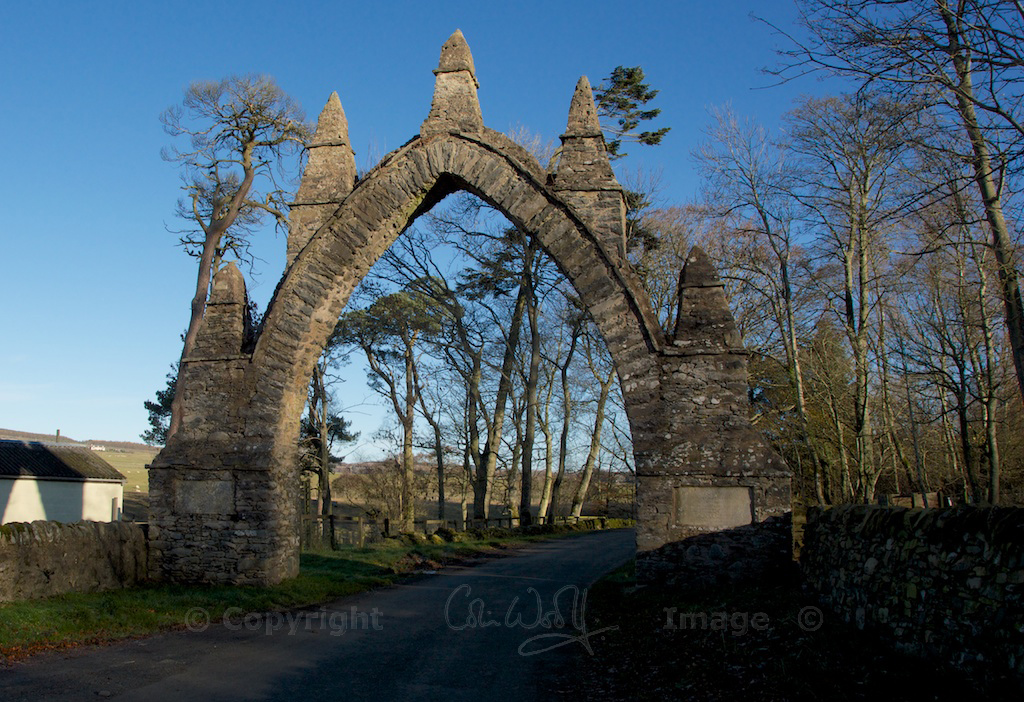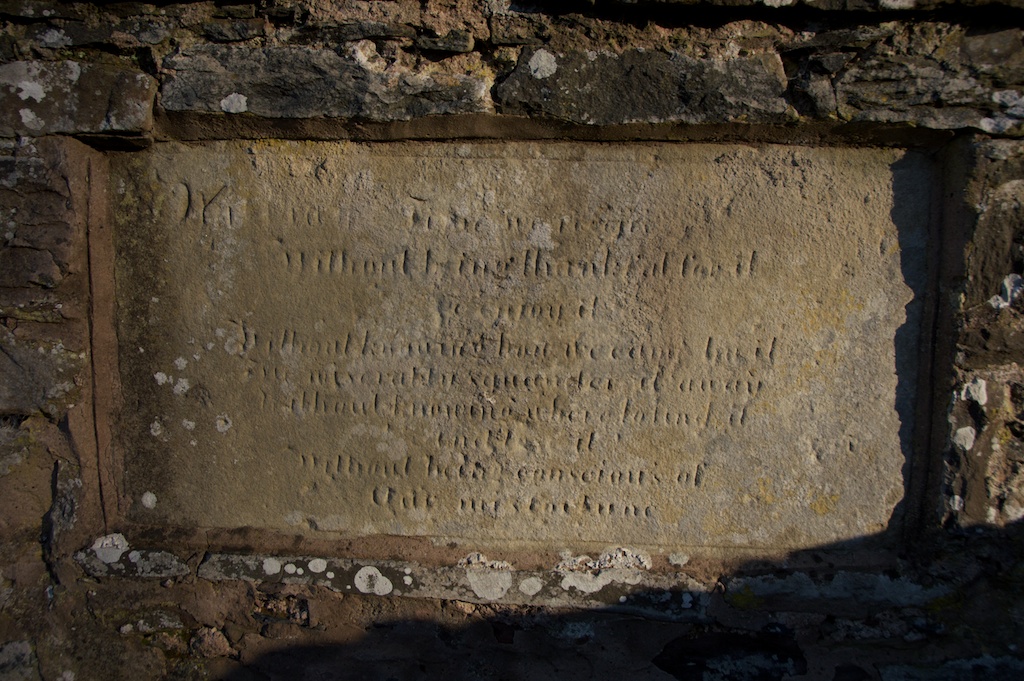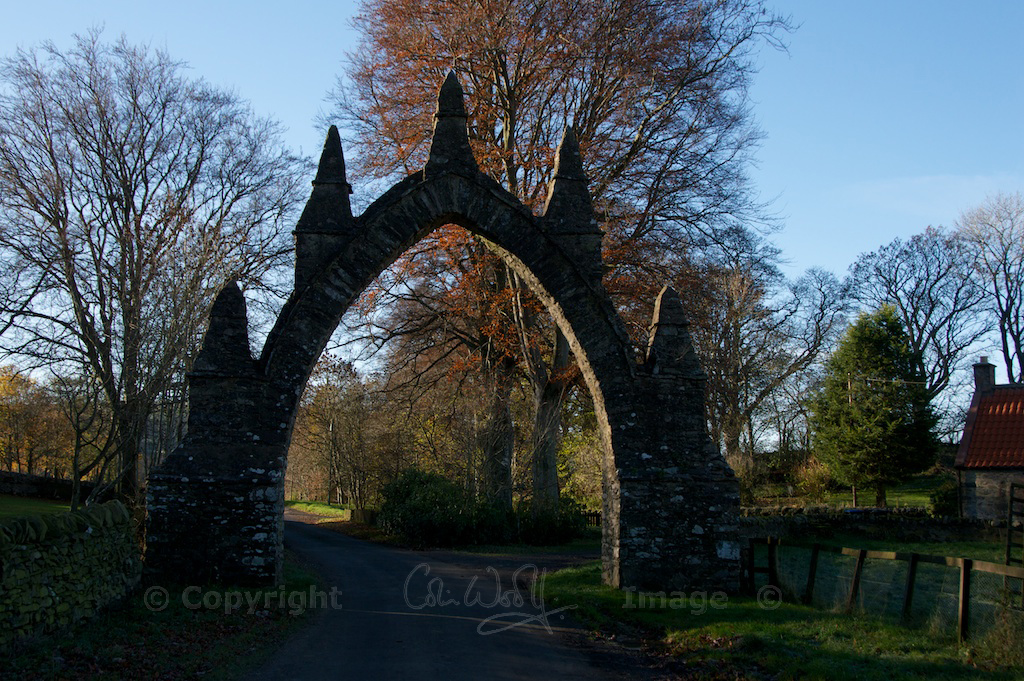
Two old arches and a warning in stone
 In the Scottish Borders the minor roads seem to wind their way forever around the low rolling hills, following river valleys and then slowly climbing to reveal views of rich farmland.
In the Scottish Borders the minor roads seem to wind their way forever around the low rolling hills, following river valleys and then slowly climbing to reveal views of rich farmland.
A few miles to the east of Lauder are two stone arches, set about a mile or so apart on the same road. I have looked for information about them online, but there is very little available. I believe they date from the 1700s, and I can only imagine that they were put up to mark the boundaries of an estate.
I noticed that the first arch had an inscription carved in the base of each pillar. The words are badly weather-worn, but I took a photo of the one that wasn’t in shadow in the hope that I could decipher it when I got home. After a few attempts I made out the following lines. If you can add or amend anything, or if you know any more about the history of the arches, please let me know! (Clicking on the image will enlarge it.)
[……….Time………….]
Without being thankful for it
we enjoy it
Without knowing how we came by it
We miserably squander it away
Without knowing where to find it
we [lose?] it
WIthout being conscious of
Our misfortune
I haven’t heard these words before, and I wonder what led someone to have such a salutary warning set in stone. It was impossible to make out the words on the other side of the pillar, as they had been worn almost entirely away.
It’s surprising what you come across along country lanes!
Footnote – 1st August 2014:
I have heard from the Borders Family History Society, who have kindly shared the following information:
“Spottiswood House was ‘Jacobethan’ style, huge, and built 1832-4 by the architect William Burn. The Gothick archways at Pyatshaw and Bruntaburn were part of its policies and landscape, and the various inscriptions are the work of Lady John Scott (Alicia Anne Spottiswood), a noted antiquarian who excavated a number of burial mounds in the area.
The magnificent house was demolished as far back as 1928.”
I found an old postcard with a view of the house on the Dunse History Society website. In the opinion of the RCAHMS, “It is very likely that the first house of Spottiswoode was a tower-house of late medieval date”, but this original building was obviously much altered by successive generations.
Peter Munro, the Chairman of the Borders Family History Society, has found the wording of the inscription in a 1770 copy of the Town & Country Magazine (see also his comment below).
I’m indebted to the Society’s secretary, Ronald Morrison, and to Peter Munro and their committee for helping me with this mystery. Since my own maiden name was Scott, I am even happier! The Scotts were one of the predominant families of the Scottish Borders. It seems that Alicia Anne’s family name, Spottiswood, has roots that go back to the 13th century, to the reigns of Alexander III and Robert the Bruce.
Photos copyright © Jo Woolf







17 Comments
Rachael Hale aka the 'History Magpie'
What an amazing, and intriguing, find. It really gets the imagination firing doesn’t it?
Jo Woolf
It certainly does, Rachael! You could write a book around them! I don’t remember seeing anything in quite this style before.
Rachael Hale aka the 'History Magpie'
Oh the mystery deepens, how fantastic!
Jo Woolf
I’ve just added a footnote, which you might find interesting! 🙂
CW
*sigh*
CW
Okay now that I’ve snapped myself out of the magical reverie your blog always evokes, I had to do a little snooping around.
The information on Wikipedia for the town of Lauder *may* shed light on the arches. It’s quite possible I’m stretching things a bit, but you can judge me ignorant if you wish. 🙂 This paragraph caught my attention, though:
“The ancient settlement was further up the hills on the edge of the Moor.[4] Its name is unknown, but it was tiny.[5] The New Statistical Account of Scotland (vol.II) says that the present town of Lauder existed as a kirk-town in the time of David I (1124–53), and Sir J.D.Marwick says, in his preface to the Records of Convention, that the present town of Lauder existed in the latter half of the twelfth century. The town was once surrounded by walls with gates commonly referred to as ‘ports’. Two major mills, which dated from the 12th century, also served the town.”
The reference at the end of the article for both Note 4 and Note 5 are ‘The Roads of Mediaeval Lauderdale by R.P. Hardie, published in 1942
The second to last sentence is what caught my attention and I wonder if the two arches are ports.
Jo Woolf
I would never judge you ignorant, and thank you so much for taking the time to look this up! I didn’t know that Lauder had ‘ports’ in its walls, although I am not surprised that the town has such ancient roots. In this case, I think the two arches are too far from the town to have this purpose, and to me they look more decorative than defensive. I am inclined to think that they date from the late 1700s when the Spottiswoode Estate was ‘greatly expanded’ according to a local report, with gatehouses and lodges being built, presumably for staff and gamekeepers etc. The entrance to the old Spottiswoode House lies between them on the minor road, although the house itself has been demolished. Just speculating now, but they could have been put up as a memorial to someone (the inscription doesn’t suggest a happy occasion!) – perhaps a local landowner. None of the online historical databases have any record of the inscriptions. If I find out any more, I will update the information!
Jo Woolf
Further to my previous reply, I’ve had some new information about these arches that you might be interested to read. (I’ve updated the article with a footnote!)
CW
You and your blog will get top billing in the thanks if I ever manage to finish my book for your amazing inspiration.
Jo Woolf
Haha, bless you! 🙂 Glad to be of help!
Peter Munro
This is known as the Pyatshaw Archway. It’s just off the A697 near Dod Mill.
A similar archway (now covered with ivy) is said to be at Bruntaburn Mill.
Google is a wonderful tool. I found a fuller inscription at
http://books.google.co.uk/books?id=Dv82AAAAYAAJ&pg=PA153&lpg=PA153&dq=%22Without+being+thankful+for+it+we%22&source=bl&ots=aruptRT5qy&sig=0hs316K-995pIvXrozKZ3JEhK74&hl=en&sa=X&ei=xmnZU6uOJ_Gu7AbejIG4Cg&ved=0CCgQ6AEwAQ#v=onepage&q=%22Without%20being%20thankful%20for%20it%20we%22&f=false
Peter Munro
Chairman/Webmaster
Borders Family History Society
“Helping people to discover their Scottish Borders family history”
52 Overhaugh St, Galashiels, TD1 1DP, Scotland
http://www.bordersfhs.org.uk
Scottish Charity no SC005531
Keep up to date with our blog on http://blog.bordersfhs.org.uk/ and
on Facebook at http://www.facebook.com/pages/Borders-Family-History-Society/183462744510
Read my column, Kith and Kin, every week in the Border Telegraph and Peeblesshire News.
Follow the Society @BordersFHS on Twitter.
Jo Woolf
That’s wonderful to have the full inscription – thank you. Do you happen to know who had the arches put up, and when or why?
Justin Davern
I’m a direct descendant of the Spottiswood family. This information is fascinating. Thank you for posting it!
– Justin Davern
My fathers last name is Spottiswood, I have my mother’s maiden name.
Jo Woolf
That’s amazing! So glad you found this post and found it interesting! I was really puzzled by that inscription and frustrated that much of it was illegible. A lovely little piece of local and family history. Thanks for getting in touch!
Roland Spottiswoode
Thank you Jo for a most evocative piece with some lovely photographs. I’ve stopped off at Spottiswoode a few times on my way back from Edinburgh to Ireland (yes, I know, it’s exactly the wrong way, but I factures this in!!) and your piece here very much gives the atmosphere of the site.
The nineteenth century house survived until Herbert Spottiswoode’s death and my grandfather had visited it a few times in the 1920s. It went on sale in October 1935 and I was told that it was finally demolished in 1938.
Herbert was the nephew of Alicia Spottiswoode, and was an enthusiastic early flyer. He believed that the gates were a rebuilt version of earlier seventeenth century gates, but if he was right it supports your assessment of their connection with the eighteenth century rebuilding work,
Jo Woolf
Thank you very much for your comments, Roland, especially in view of your family connection! Very interesting to hear about Herbert Spottiswoode and his belief that the gates were rebuilt versions of 17th century ones. He sounds quite a dashing character himself. I wonder what inspired the inscriptions? I found the arches fascinating as I’d never seen anything quite like them before. With best wishes, Jo
David Kirkwood
Hi everyone. Not sure whether anyone can help, but by some of the names above I hope so. I have a relation, William Kirkwood, who lived in Brotherfield, Spottiswoode in1715. The only mention of Brotherfield I can find is Brotherfield Cairn discovered in 1770.
Can anyone give me any info on Brotherfield, William Kirkwood, or his children, Elspeth, Margaret, Thomas, Agnes or my great, great, great, great, great grandfather John Kirkwood.